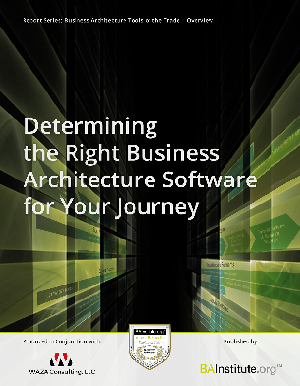Home / Resources
Resources
Discover a Wealth of BPM Knowledge and Expertise at BPMInstitute.org!

Taking Operational Excellence to the Next Level
Best in class companies understand that Operational Excellence (Op Ex) is the means to an end and not an end in itself. Yet, many organizations dedicated to Op Ex focus mostly on assuring that the core skills of Lean and Six Sigma are in place and that people understand work as a process. In some cases, companies choose to deploy Op Ex along departmental lines and fail to take full advantage of removing the non-value added steps residing in cross functional handoffs. While building the foundation for Op Ex is important, it’s not enough on its own. A company intent on taking Op Ex to the next level may wish to consider the following four tactics.

Real Business Architecture in Action© Part 4 of 4
This is the fourth and final article in a 4-part series of articles on architecture presented by the BAInstitiute. If the reader has not read the previous three articles in this series, the reader is encouraged to begin the series in its proper sequence.

The Business Architect Collaborator
Business architects don’t control large budgets nor do they command large groups of people. With little money and less authority, business architects’ success hinges on their ability to create value through others. In pursuit of that goal many business architects attempt to implement governance mechanisms with little success. One of the biggest lies analysts and other BA pundits tell us is that governance is a best practice. A best practice is something that works for a significant number of people in a wide variety of circumstances. Given that business architecture governance is something tried by a large number of people with little success, maybe we should call it a worst practice. Gaining senior level support in hopes they will direct others to follow our lead isn’t much better. Successful business architects recognize that collaboration is a key element in reaching their goals.
Business architects collaborate with a wide group of people:

3 Reasons Rules Architects Are Adopting Decision Modeling
Rules Architects are increasingly using decision modeling as part of their business rules management system (BRMS) implementations. This article will explore three key benefits of using decision modeling and a BRMS.
- Business Engagement
- Expanded Traceability and Impact Analysis
- Using agile not waterfall to write the rules

Report Series: Business Architecture Tools of the Trade
About the Report Series: Business Architecture Tools of the Trade (BATT)
BAInsitute.org has commissioned this one-of-a-kind report series to provide practitioners with the perspectives they need to understand the tools landscape.
BATT Overview Report: Determining the Right Business Architecture Software for Your Journey
This Business Architecture Tools of the Trade (BATT) overview report will provide guidance in selecting the right tool for the right job by categorizing and matching tools to practice segments within your organization.
This Report:

Collaborate Around Processes
Most of us see a business application (say an HR system) and email or any other collaborative application like Sharepoint as totally separate systems, although we use both to get our work done. One reason could be that the two applications are used at different times for different purposes- for example; a company might see email as essential but not invest in an HR application until they reach a certain size.

Using BPM to Meet Today’s Supply Chain Challenges
In today’s demanding business environment that prioritizes flexibility, speed, quality, efficiency, effectiveness and innovation, a competitive supply chain strategy and its operational execution is critical. Business Process Management (BPM) helps an enterprise achieve these characteristics in its supply chain strategy – and in its execution of that strategy. Applying the BPM discipline achieves process improvements that lead to organizational performance improvements – such as a Supply Chain.
Supply Chain & Logistics Challenges

Business Architecture: From Startup to Sustainability
In this webcast, Jeff will pinpoint the critical challenges of starting a business architecture practice and identify the specific steps you can take to move from startup to sustainability. Jeff will talk about the current state of the business architecture profession, roadblocks to avoid and best practices from successful business architecture practices.

Real Business Architecture in Action© Part 3 of 4

Business Architecture: A Noble Profession
The Profession
Let’s take a little time to think together about this profession, this discipline, that we call business architecture. It’s not uncommon to find discussions about how to define this discipline, its responsibilities, and where it should report in an organization structure. Let’s take a slightly different perspective here on the nature of this work.

Requirements for Operational Excellence Success
In the past few years Operational Excellence (OpEx) has become one of the most prominent trends in the improvement arena, many large corporations have ambitiously applied OpEx. Because the results have often been extremely good, this has stimulated growing interest among other organizations. A serious drawback of the increasing attention that OpEx is receiving is that some companies choose to be trendy and simply follow the herd without questioning, adapting and designing an OpEx program to suit their own specific needs.

Cognitive BPM Business Processes Awaken!
It should come as no surprise to all serious professionals that the age of Artificial Intelligence, Machine Learning, and Data Analytics is here – this time, to stay for good.
The first time around, back in the early 80’s to mid-90’s – a period of roughly two decades – AI got a lot of exciting hype, especially around the topics of Expert Systems, Natural Language Processing, and Computer Vision. The premise underlying all of AI at that time was that the human capability of learning was really a set of as yet unknown algorithms that knew how to take data of various types and reason from it. However, the common perception was that the promise of AI had not been met.

Real Business Architecture in Action© Part 2 of 4
This is the second article in a 4-part series of articles on architecture presented by the BAInstitiute.
In the first article of this series, the reader was asked to visualize how to create a typical low-level workflow model from an enterprise template of architectural primitives or formally defined elements of the enterprise. In the Business Architecture (BA) tool referenced in the first article, all of these design elements were operationally current and available from the enterprise template to quickly build low-level workflows. The workflow creation was illustrated in a short youtube animation on how to use the enterprise template to assemble a generic workflow.

Beyond DMN1.1: What’s Next?
With the (almost) official release of DMN1.1 we find ourselves at an interesting crossroads in the industry as the concept of consistently modeling decisions becomes more widespread. It seems clear that we’ve moved from questions of “What is this?” to “How can we effectively leverage it?”. A plethora of companies have developed platforms to support DMN or at least support it through some kind of adapter. Gartner has commented on it and MISMO (Mortgage Industry Standards and Maintenance Organization) is moving towards adopting it as an official standard for exchange and interchange in the mortgage industry.
This crossroads also includes fundamental questions surrounding what we can do, what we can’t do, and what we should be doing with the standard. I’ve seen this manifest itself in two primary ways:
- Modeling vs. Implementation
- Methods to implement, share, disseminate and execute decision logic
These will both be discussed here.

Designing an Effective Business Architecture Team
As organizations set out to establish their own internal business architecture practices, some of the most frequently asked questions are about how to structure the business architecture team and role. These are indeed important considerations because the structure significantly contributes to both the effectiveness and success of a business architecture practice. How the team is structured and positioned, and how the business architect role is defined directly and indirectly speak volumes about strategic importance, scope of responsibility and key relationships. Certain choices made up front will make it easier to obtain organizational buy-in and perform the role at a strategic level.
Key Structural Decisions
While there are certainly other considerations, a few key decisions need to be made once an organization has decided to formalize a business architecture practice.

The Systems Approach to Performance Improvement: A Personal Experience
In the late 1970’s, I was a training manager in charge of teller training at a bank in the Midwest. I read Geary Rummler’s article “You Need Performance, Not Just Training” and experienced a Eureka! moment because I had just witnessed the exact scenario described in the article: an inept attempt at engineering the desired performance of tellers. This is the story of what happened before and after I applied Rummler’s principles of systematic performance improvement.

Dealing with Cultural Challenges in Operational Excellence
Operational Excellence focuses on providing the best execution of service and process for the benefit of the customer and the organization. It is not a proprietary program or methodology; rather, the term usually represents a conglomeration of process methods and techniques to improve operational discipline, its performance metrics, and customer satisfaction.
Operational Excellence is an enterprise approach. Companies want to address more end-to-end processes, going beyond earlier smaller process improvement projects in one department. For end-to- end processes to be successful organizations need to have consistent execution aligned with organizational purpose, leadership accountability that spans organizational boundaries, and employee skills and behaviors that see the flow of work across the organization and make results happen for the customer.

Real Business Architecture in Action© Part 1 of 4
This is the first article in a 4-part series presented by the BAInstitute.org.
For many new business and IT professionals entering the field of Business Architecture (BA), an exciting opportunity is at hand. However, these new entrants must consider beginning their career expanding endeavors with a clear and solid foundation in architecture principles. In this article, the reader is asked to participate in a visualization exercise in order to understand real Business Architecture in action.

Implementing Enterprise Business Process Management – The change starts with the practitioner
Over the past year, our Business Process Excellence practice has been working to develop an Enterprise Business Process Management (BPM) Framework for our organization, with implementation beginning this year. We utilize Lean, Six Sigma, Workout, Kaizen and facilitation methods to improve business processes that drive measurable business outcomes. BCBSNC is an $8 Billion dollar business with over 4500 employees and have had an established Business Process practice since 2008. We have a very strong brand and have driven over $80+ million in results since inception.

Operational Excellence and Superior Customer Experience
Each quarter, the American Customer Satisfaction Index issues an update of overall U.S. customer satisfaction. The national ACSI score for the period 1994 through 2015, as depicted below, reflects an aggregate of customer satisfaction with companies that comprise a large cross-section of the economy.*













